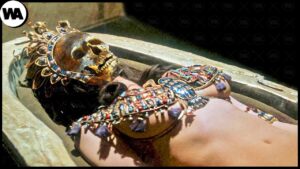In a groundbreaking archaeological discovery, a team led by renowned archaeologist Kathleen Martinez has unearthed a vast complex of tunnels in the ancient city of Tapasyrus Magna, located in Northern Egypt. The tunnels, spanning over 4,200 feet, led to a massive religious center containing three sanctuaries and more than 1,500 artifacts, including busts, statues, and gold coins. However, the most intriguing find was a network of tunnels leading to sunken structures, believed to be the lost tomb of Cleopatra.
 The ancient city, marked by numerous earthquakes over the centuries, may have seen the collapse of these tunnels. Kathleen Martinez is convinced that this discovery could be the long-sought resting place of Cleopatra, marking it as the most significant archaeological find of the 21st century.
The ancient city, marked by numerous earthquakes over the centuries, may have seen the collapse of these tunnels. Kathleen Martinez is convinced that this discovery could be the long-sought resting place of Cleopatra, marking it as the most significant archaeological find of the 21st century.
The recent revelation sheds light on the mysterious queen Cleopatra, challenging the conventional perception of her as a paragon of beauty. Cleopatra, the last ruler of ancient Egypt, ascended to the throne at the age of 18, possessing unparalleled intelligence and political acumen. Fluent in nine languages, well-versed in politics, economics, and mathematics, Cleopatra defied societal norms, emerging as one of the first influential women in history.

The prevailing image of Cleopatra as a captivating beauty stems largely from Roman accounts, painting her as a rival to their empire. However, the lack of concrete evidence and the absence of Cleopatra’s tomb have kept her true appearance and legacy shrouded in mystery.
If the tunnels at Tapasyrus Magna indeed lead to Cleopatra’s tomb, it could provide invaluable insights into her life, appearance, and the customs of ancient Egypt. Current knowledge about Cleopatra’s physical features relies on unreliable sources such as coins, Egyptian reliefs, and marble busts. A 2,000-year-old silver coin portrays her with distinct features, challenging the widely accepted perception of her beauty.

Historians question the romanticized image of Cleopatra, emphasizing her intelligence and charisma rather than focusing solely on physical allure. Cleopatra’s success in ruling Egypt and forming alliances was attributed to her political acumen, overshadowed by later narratives that attributed her achievements to her beauty.
Among the speculated beauty rituals of Cleopatra was bathing in donkey’s milk, believed to enhance skin softness and whiteness. While ancient cosmetic practices might seem unconventional today, they reflect the beauty standards of that era.

Archaeological endeavors have also attempted to recreate Cleopatra’s perfume, named UDA Cleopatra, using advanced technologies to analyze molecules found in ancient perfume jars. This olfactory recreation offers a glimpse into the aromatic preferences of the enigmatic queen.
The archaeological journey to uncover Cleopatra’s tomb remains ongoing, and the recent findings at Tapasyrus Magna open new possibilities for unraveling the mysteries surrounding one of history’s most fascinating figures. If successful, this discovery could reshape our understanding of Cleopatra’s life and legacy, challenging the enduring myth of her unparalleled beauty.




